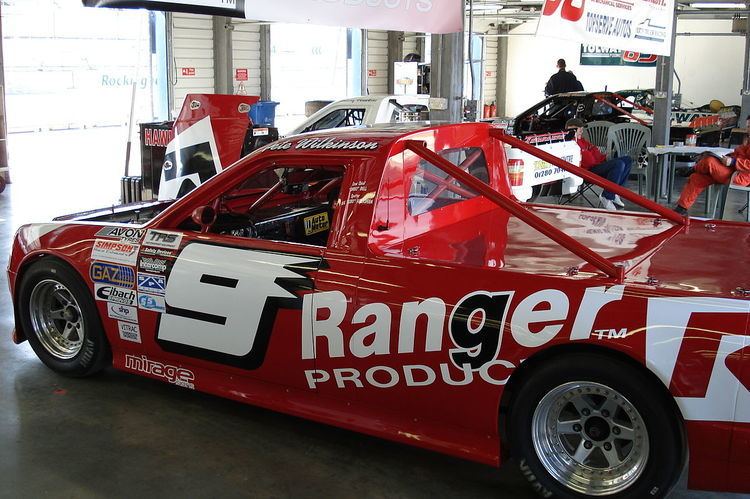Inaugural season 1997 | Country United Kingdom Constructors SHP Engineering | |
 | ||
Pickup Truck Racing is an auto racing series, running in the United Kingdom, including races on both road courses and ovals. It is currently the only racing series that races on the Oval Circuit at Rockingham Motor Speedway.
Contents
History
Launched in 1997 by Sonny Howard, the Pickup Truck Racing series, intended to bring the American pickup truck culture to Europe, is for purpose built 230 bhp (170 kW) racing specials. They have a tubular space frame chassis, are powered by a 2 litre multi-valve twin-cam engine and weigh 900 kg (2,000 lb). The race trucks are designed to place an emphasis on driver ability.
In 2001 the Pickup series became the main support for the Rockingham-based oval SCSA (then called ASCAR) racing series. At this time the Pickups were right hand drive in configuration and as such not permitted to race on the anti-clockwise 1.5-mile speedway. An 'oval' course was created to allow the drivers to compete.
For the 2003 season the Pickups were converted to left hand drive and finally allowed onto the oval track, as can be seen.
Pickup Truck Racing is unique in 'big' oval racing, in that unlike e.g. NASCAR the trucks have rain tyres, wipers and rear safety lights, and will race on the ovals in the wet. Speeds are about 18 mph slower than when racing in fully dry conditions.
Pickup Truck Racing is also the only racing series in the UK for which no race-by-race entry fees are charged.
Technical specification
Pickup Truck Racing is a single make series, and the trucks are governed by the Pickup Truck Racing regulations. The chassis is made by SHP Engineering, who are also responsible for the vehicle used in T Cars, a series for young drivers.
The main flexibility in the regulations comes in the choice of engine. From 2011 the trucks could be fitted with either a Vauxhall Petrol Injected 2 litre red top engine or a Ford Duratec engine, both of which are four cylinder engines with a 2 litre capacity and 16 valves.
In 2010 the front end of the pickup trucks was changed with the choice of either an Isuzu Denver Max LE or a Ford Ranger Front. Later in the year a Vauxhall front was then also introduced to the Championship.
Race format
Under normal circumstances race weekends follow the traditional format of practice and qualifying on the Saturday, and two races on Sunday. Qualifying is used to shake the car down and work on the setup, and to meet the MSA requirements for race entry of three qualifying laps, and not to set the starting grid.
The grid is set by reversing the top 10 qualifiers (whoever qualifies 10th will be on pole, and whoever qualifies 1st will start from 10th). The top 10 qualifiers also receive points, starting from 20 and decreasing by 2 for every place until 10th place, after which drivers receive 0 points. Rookies always start from the rear of the grid as do competitors who have broken seals on controlled components such as differentials. Drivers can also elect to start from the back should they wish to do so.
At some circuits, qualifying takes place on Saturday morning, with the first race on Saturday afternoon and the second on Sunday.
Previous seasons
For the 2009 season, races will take place on weekends between March and November. There will be racing weekends at six different circuits; the majority of the races were held at Rockingham Motor Speedway but others will be held at Brands Hatch, Thruxton, Silverstone, Pembrey, Donington Park and Oulton Park. Each round will comprise two races, making a twenty two round competition in total.
2009 will see a number of rule changes:
Qualifying
One qualifying session will be held, split into two sections. The fastest ten drivers in the first session will make up the first ten places on the grid, but in reverse qualification order. The second session will be the same, but for race two.
Success Ballast
The podium finishers in each race will be subject to the application of success ballast as follows:
1st: 30 kg 2nd: 20 kg 3rd: 10 kg
Ballast will be applied up to a maximum of 70 kg. 10 kg will be removed each time a truck finishes outside of the top three.
Sprint/Feature Races
Two events will host a Sprint/Feature race format; one at Rockingham and one at a road course
The series will continue to operate two championships: the Oval Championship and the Overall Championship
Previous champions
Note: 1997 was the inaugural year and as such, races were not part of a championship
Points system
Any other classified finishers receive 20 points and any non-finishers receive 10 points except in the case of disqualification.
